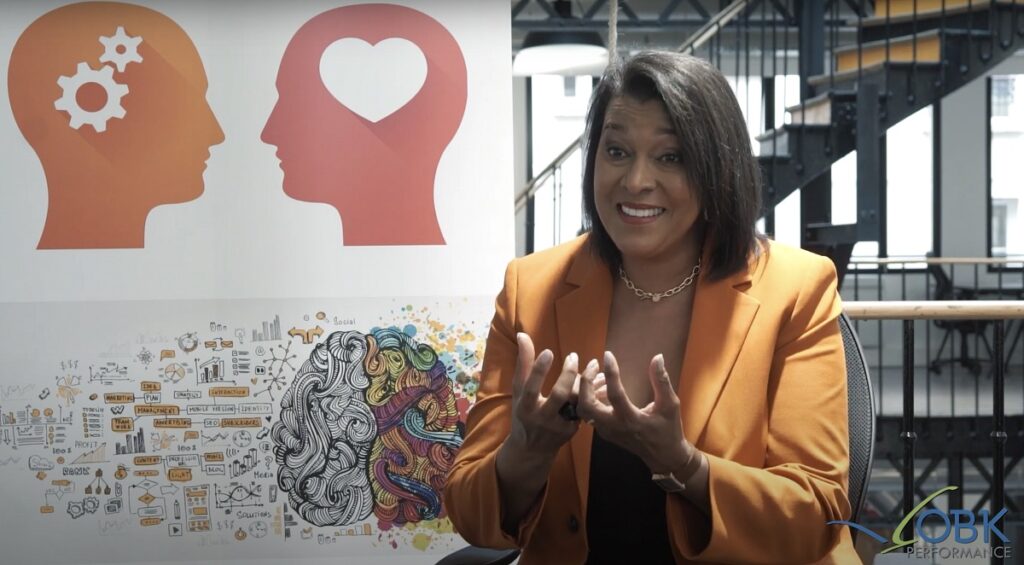In the next installment in our series on emotional intelligence in the workplace, ESCP takes a closer look at the preconceptions around gender and emotional intelligence. Why do we often associate emotional intelligence with female leadership? And is today’s renewed focus on this ‘soft skill’ finally tipping the balance in favour of women when it comes to management and career advancement? We spoke to Emotional Intelligence (EQ) expert and coach Odile Bocande-Koffi, who shared her thoughts on emotional intelligence, gender and the workplace.
Thank you for sharing your expertise, Odile! For a start, how would you define emotional intelligence?
Odile Bocande-Koffi: First off, there is a standard definition of emotional intelligence. The ability to understand our own emotions, and those of others – and to use this information to adapt our behaviour and our thinking, so that we can react appropriately. More widely, EQ is composed of fifteen skills, which can be associated with 5 main competencies, the first one being: understanding who you are, expressing your thoughts appropriately, interacting with others in a healthy way, making decisions with confidence, and managing stress.
How do you put this into practice with your clients – and do the people you work with share any common traits?
Odile: Self-evaluation is very important. I conduct most of my workshops face-to-face with a single participant and we always begin using the results of an EQ test showing the client’s top three strengths and areas of progression in terms of emotional intelligence leadership skills. During coaching sessions we work on strategies in order to meet the necessary criteria – the necessary levels of empathy, self-expression, and so on – to be an effective leader. When working with groups, we often use role-play activities, keeping confidential the results of each participant inventory (test) .
My clients are obviously all different, but they share a common interest in better understanding who they are – which is very positive! At the executive level, 70% of my customers are men, many of whom are highly performance-oriented. At the beginning they may experience a little difficulty in assessing the practical benefits of EQ reinforcement, but they soon begin to see results.
We all have different ways of expressing ourselves – some ways are healthy, others are less healthy – but we all experience the same emotions.
There have been a number of anecdotal and research cases associating women with higher emotional intelligence. What are your thoughts on this?
Odile: I disagree. We all have different ways of expressing ourselves – some ways are healthy, others are less healthy – but we all experience the same emotions. Of course, some skills, such as empathy and interpersonal relationships, tend to be associated with women, while other skills, such as increased resistance to stress, tend to be associated with men – which is certainly something I have noted in my work. That being said, I firmly believe that this is down to cultural reasons that encourage the ‘practising’ of certain EQ markers depending on gender. When it comes to displaying EQ, certain behaviours may differ between men and women, but the emotions guiding those choices certainly don’t.
Would you agree that part of the reason for women’s historical underrepresentation in management roles is due, at least in part, to poor valuation of these skills?
Odile: Absolutely. While I don’t necessarily believe that women are innately more emotionally intelligent than men, my female clients often speak of wanting to combat impostor syndrome, of a desire to feel legitimate in their role. The EQ skills here are self-regard and self-actualisation. For example, when interviewing for a new role, many women feel they need to tick every box in the list of requirements. Men, on the other hand, tend to apply as soon as they feel they’ve met the majority of requirements rather than all of them.
Today, I would say that relatability in the workplace is more important than ever. A strong leader needs to embody accountability, approachability, and authenticity just as much as they need to display competence and expertise.
Today, it seems that qualities typically associated with high emotional intelligence – empathy, compassion, humility – are increasingly demanded of all leaders, no matter the gender. Would you agree, or do you still consider emotional intelligence to be gendered?
Odile: Historically, emotional expression has been viewed as a weakness for male leaders, but times are changing. Men are valued more and more for their empathy as opposed to just their efficiency and competence, but often more is expected of women – the capacity to navigate complex and challenging emotional relationships, while displaying emotional strength and resilience. Today, I would say that relatability in the workplace is more important than ever. A strong leader needs to embody accountability, approachability, and authenticity just as much as they need to display competence and expertise. You can’t have one without the other.
Finally, what advice would you give women – and men – on displaying and developing EQ in the workplace?
Odile: I would encourage anyone who is interested in developing their EQ to begin by identifying their strengths and skills to improve on a personal level. Do not be too perfectionist – focus on three points to improve as a priority and build on your EQ strengths. Set up a clear action strategy to gain new habits. After all, developing your EQ is a lifelong skill. Moving forward, I recommend using tools such as neurolinguistic programming anchorage as a reminder. I use a positive anchorage, such as hand gestures, that remind me of a moment where I was able to rise above pressure, anchoring me in the workplace and during moments of stress. Finally, monitoring your progress with a tracking tool can really help to provide clarity on how you’ve been integrating your EQ training into your daily life.
